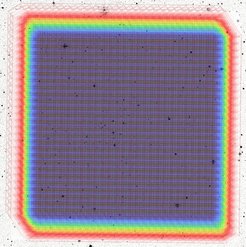Fields
The PEP survey includes six of the most widely studied blank fields across the sky, two high-redshift galaxy clusters, and ten lensing clusters.
For infrared surveys, galactic foreground is an important driver in field selection in order to minimize cirrus confusion. At the spatial resolution of Herschel, extrapolations of cirrus noise from previous lower-resolution data (Kiss et al. 2005, Jeong et al. 2005) compare favorably low to extragalactic source confusion, allowing us to survey not only fields with absolutely minimal foreground (e.g. Lockman Hole), but also fields with I(100) ~ 1 MJy/sr (e.g., COSMOS) but excellent multiwavelength coverage.

Therefore, the availability of multiwavelength data and follow-up opportunities are prime selection criteria. To address our science goals, we have ensured that our chosen fields are fully covered in several of the following: deep X-ray surveys, UV/optical/near-infrared/IRAC imaging, HST imaging, Spitzer mid-infrared surveys, (sub-)mm surveys, and radio mapping.
The z = 1 massive clusters and lensing clusters are chosen to be among the best-studied of their category, the latter having known high-redshift background objects – in particular (sub-)mm galaxies and LBGs – for detailed study.
We use the unchopped scan mapping mode of the PACS photometer AOR, which is the default for PACS photometric mapping of large areas. It is also preferable for imaging close to the source confusion limit since it avoids additional noise induced by negative beams that would be present in chopped data. This is important as PEP data are at and partly deep into the confusion limit at 160 microns. To improve redundancy of the data and facilitate map reconstruction, including possible low-spatial-frequency components, we define two basic versions of the mapping AOR for each field, which scan the field in orthogonal directions. For the larger fields, each AOR version is defined in two flavors for each of these directions, starting in opposite corners of the map respectively.
For most of our maps, we use scanning in sky coordinates to optimally match the PEP survey to the known coverage of key multiwavelength data sets. To avoid coverage holes due to the PACS intermatrix gaps, small cross-scan separations have been adopted, ensuring a good coverage for all observing dates.
All PEP fields are covered by SPIRE observations in the coordinated key program HerMES of SPIRE SAG1, with the exception of the two z ~ 1 clusters in our program. PEP include confusion-limited SPIRE scan maps of these two targets, covering the full area mapped with PACS.
A list of the PEP fields and main observing parameters is provided hereafter.
Blank Fields
(*) The 100- and 160-micron sensitivities of the GOODS fields refer to the combined reduction of PEP and GOODS-Herschel data, as described by Magnelli et al. 2013.
z ~ 1 Clusters
| Field | Center RA, Dec |
Area | P.A. of map on sky [deg] |
Total exp. [hours] |
5 sigma (70) [mJy] |
5 sigma (100) [mJy] |
5 sigma (160) [mJy] |
| MS 1054 | 10:57:00.2 -03:37:27 |
5'x10' | 0.0 | 5 | – | 5.50 | 12.85 |
| MS 1054 (SPIRE) | 10:57:00.2 -03:37:27 |
5'x10' | 0.0 | 0.84 | – | – | – |
| RXJ 0152.7 | 01:52:41.0 -13:57:45 |
5'x10' | 45 | 5 | – | 5.70 | 12.75 |
| RXJ 0152.7 (SPIRE) | 01:52:41.0 -13:57:45 |
5'x10' | 45 | 0.84 | – | – | – |
Lensing Clusters
| Field | Center RA, Dec |
Area | P.A. of map on sky [deg] |
Total exp. [hours] |
5 sigma (70) [mJy] |
5 sigma (100) [mJy] |
5 sigma (160) [mJy] |
| Abell 1689 | 13:11:30.3 -01:20:24 |
4'x4' | 45 | 13 | – | 2.85 | 6.90 |
| Abell 1835 | 14:01:02.0 +02:52:44 |
4'x4' | 45 | 5 | – | 4.45 | 10.50 |
| Abell 2218 | 16:35:53.0 +66:12:22 |
4'x4' | 45 | 13 | – | 3.55 | 9.15 |
| Abell 2219 | 16:40:20.0 +46:42:43 |
4'x4' | 45 | 5 | – | 4.15 | 9.90 |
| Abell 2390 | 21:53:37.0 +17:41:44 |
4'x4' | 45 | 5 | – | 4.55 | 12.70 |
| Abell 370 | 02:39:53.0 -01:34:43 |
4'x4' | 45 | 5 | – | 4.50 | 11.40 |
| CI 0024+16 | 00:26:36.0 +17:09:45 |
4'x4' | 45 | 6.4 | – | 4.85 | 11.35 |
| MS 0451.6-0305 | 04:54:12.0 -03:01:00 |
4'x4' | 45 | 5 | – | 4.30 | 11.20 |
| MS 1358+62 | 13:59:54.3 +62:30:36 |
4'x4' | 45 | 5 | – | 4.30 | 10.60 |
| RXJ 13475 | 13:47:30.5 -11:45:09 |
4'x4' | 45 | 5 | – | 4.45 | 10.85 |
